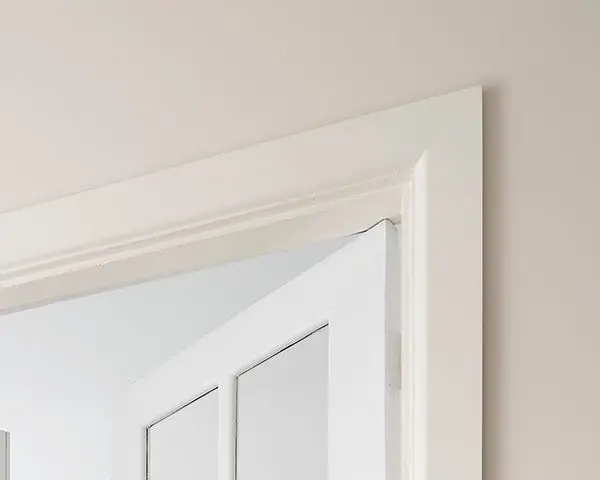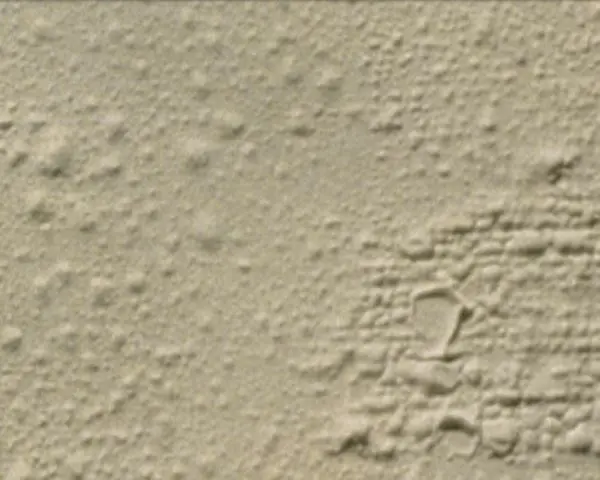Find out everything you need to know about paint efflorescence.

Find out everything you need to know about paint efflorescence by downloading the Dulux Technical Advice brochure.
What is Efflorescence?
“Efflorescence” is the term most commonly used to describe the deposit of crusty white mineral salts that appear on a masonry surface (concrete, render, brick or mortar) that have leached out from within the substrate when moisture migrates through it.
Any efflorescence on the surface must be removed prior to painting as it is regarded as a poor and friable base that prevents paints and coating systems from adhering effectively.
Paint systems adhering normally to the surface of the substrate can also be forced off (delaminate), when the pressure caused by the growth of salt crystals builds up beneath the paint film, resulting in its gradual but irreversible destruction.
Since the mineral salt crystals are not fluid, the pressure is therefore not uniform hence the coating does not form smooth rounded blisters. The paint film may stretch to form the outline of the growing crystals or the paint film may just rupture, crack, flake or peel instead.
Why?
Efflorescence from masonry (concrete, render, brick or plaster) that appears as white alkaline salts on the surface, consists mainly of calcium carbonate. A reasonable amount of moisture is generally required for the formation of calcium carbonate. The carbonation process occurs when alkaline salts such as Lime (calcium hydroxide) within the pores of the substrate react with atmospheric carbon dioxide to form calcium carbonate which is transported to the surface by moisture.
Concrete or mortar with high levels of Portland Cement contains high concentrations of calcium that in turn can often produce excess salts.
It should be recognized that there must be water (moisture) present to dissolve and/or transport these salts so the source of the moisture needs to be either blocked (if it’s external to the substrate, such as groundwater) or exhausted (if moisture is emanating from within the substrate, such as rising damp).
How does it occur?
As moisture enters and moves through the substrate it dissolves mineral salts (mainly calciumit occur carbonate) that are present in the cement (or plaster). When the mineral salt solution finds its way to the surface of the substrate, the water evaporates leaving behind a white deposit of crystalline salts.
Efflorescence may occur within the first year of a new construction project and may only be an aesthetic concern on an unpainted substrate. Efflorescence due to residual moisture within the substrate will cease naturally as the masonry dries and cures. However, when the efflorescence continues unabated then it is likely that moisture ingress from an external source is occurring, which can present significant ongoing problems.
Solution
Efflorescence will only stop forming when the migration of moisture through the substrate stops. Unless the source of the water (moisture) causing the efflorescence is traced and eliminated (if possible) then it is highly likely that the salts will continue to reappear over time. Failure to remove the source of water ingress allows more efflorescence to form, resulting in subsequent damage to the existing paint coating system.
Some paint coating systems may have varying levels of resistance to efflorescence or alkalinity however there are no guarantees or warranty. Remove all efflorescence where ever possible.
Efflorescence and alkali salts can be removed by dry brushing with a stiff bristled brush followed by wet sponging the surface with a mild 5% solution of white vinegar (Acetic Acid) in water. The whole area should then be wiped down with a damp cloth and allowed to dry thoroughly.
In severe cases, remove alkaline salts by dry brushing with a stiff bristled brush followed by a stronger acidic solution (35% commercial grade calcium chloride mixed 1 part to 3 parts water) should be applied by an experienced contractor, to chemically remove/neutralize the alkaline salts then allow to dry for 48 hours.
Treatment with calcium chloride solution would NOT be necessary on concrete floors that are to be diamond ground, shot blasted or acid etched in order to provide a base for sound adhesion of coatings.
Painted surfaces already damaged by efflorescence must NOT be repainted until the source of the moisture is identified and eliminated or blocked (by waterproofing). It may be necessary to engage the services of a qualified waterproofing specialist.
The damaged paint will need to be totally removed by mechanical means and chemical stripping. The whole surface should then be washed with mild acid solution as described above, rinsed and allowed to dry. Check that the moisture content of the substrate is less than 10%.
When the surface is sound, clean, dry, free from mould & algae and ready for painting it would be wise to select an alkali-resistant sealer and appropriate topcoats.
Warnings:
Application of coatings, with “moisture barrier” properties, onto surface areas that genuinely show signs of underlying moisture or efflorescence problems are not recommended, as they are likely to either intensify, relocate or spread the problem because they try to prevent the escape of moisture from the substrate at that specific location only.
Moisture permeable coatings that allow any residual efflorescence to diffuse through the painted surface would only be advantageous, if and when further efflorescence is anticipated.
Painting over old porous or permeable coatings that appear to be sound may actually allow the salts to become trapped between the old and new less permeable coating, thus causing separation of the coating system at that interface rather than at the substrate itself.
Prevention
Without doubt, the best way to prevent efflorescence from occurring in the first instance is to put the following practices into effect at the design & construction phase:
Ensure that the substrate is fully cured (at least 28-30 days for concrete and cement render / 10 weeks for fibrous or set plaster, depending on ambient conditions) prior to painting.
Good drainage to prevent water “ponding or pooling” on horizontal surfaces. Wherever possible, keep masonry dry during construction by covering it with plastic sheeting.
Installation of appropriate moisture barriers (waterproofing) to effectively prevent rising, falling or lateral damp or any water ingress from an external location (such as soil), as this can activate the alkaline salts within the masonry substrate allowing these salts to be transported to the surface by moisture.
Avoid painting highly alkaline masonry surfaces that have a pH of 10 or over. (Note: A pH of 10 is actually 10 times more alkaline than a pH of 9 – Ref: AS/NZS 2311)
Avoid painting damp masonry surfaces that have a moisture reading above 10% (using a standard moisture meter) as the coating system can impede the desired loss of residual moisture from the substrate.
Use proprietary factory mixed cement renders that are lime free or low in calcium and polymer reinforced. Specify and select masonry ingredients which have low calcium or low salt content (eg. clean washed sand).
Protect bare and non-painted masonry from moisture ingress by applying water repellents such as silanes or silicone solutions.
References
A more detailed explanation and recommended processes can be found in the Australian Standard AS/NZS 2311 “Guide to the Painting of Buildings” Sections 3.9, 3.10 & 7.6.
Dulux Protective Coatings Tech Note 1.3.6 on “Problems with Concrete – Efflorescence” available from www.duluxprotectivecoatings.com.au
A Technical Fact Sheet on “Efflorescence Common Paint Problems” is also produced by the Master Painters NZ , which can be obtained by contacting the Master Painters staff on 0800 PAINTNZ/04 472 5870
NB: Calcium Chloride is a whitish crystalline acidic powder and requires personal protection against contact with skin and eyes, respiration of vapour, fumes & dust or ingestion of solid or liquid forms. Solutions should be made up by adding calcium chloride to water, NOT the other way around, in order to avoid splashing.
Related Technical Advice
Discover how to touch up a small area of a newly painted surface to conceal repairs to minor damage or to cover up small surface defects.
Discover the differences between water-based and oil-based enamel paints.
All water-based paints undergo a “drying process” involving two distinct phases, evaporation and coalescence.
Find out more about issues and solutions to blistering caused by Hydrostatic pressure.
Get detailed information about the physical and chemical properties of our products.
Advice for those challenges that arise in your busy and varied days.
Browse Dulux specifications, product datasheets, substrate information and safety data sheets.



